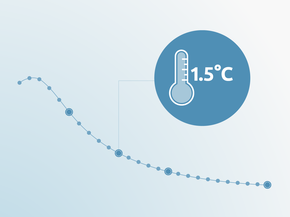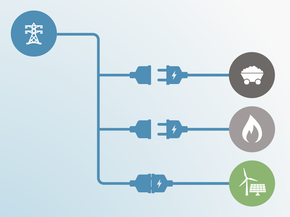Country summary
Overview
The European Union has established a well-deserved reputation as a global leader on climate policy. However, despite some progress over the last year, the EU’s climate policy has not yet effectively responded to the 1.5°C limit enshrined in the Paris Agreement, which goes beyond the former 2°C goal agreed in Copenhagen. Neither the targets, nor their implementation, are compatible with the new circumstances after the adoption of the Paris Agreement.
The EU’s present 2030 target of reducing emissions by “at least 40%” below 1990 levels represents only a slight increase in the rate of climate action compared to the preceding quarter-century at exactly the time when there needs to be a significant acceleration in order to achieve the necessary decarbonisation by mid-century. We rate this target “Insufficient”. Its 2050 goal of decreasing total GHG emissions by 80–95% below 1990 levels is also not consistent with the Paris Agreement long term warming goal. The new EU long-term greenhouse gas emissions strategy, that the Commission was called to prepare by the member states by the first quarter of 2019, offers an opportunity to increase the level of ambition to reflect the 1.5°C temperature limit.
The EU’s climate leadership is threatened further by the fact that neither the historical, nor the projected, rate of emissions reduction will allow the EU to meet its 2030 goal, at least not with currently implemented measures. The EU recognises that it is not on track to meet its 2030 target with current policies, and is discussing a large package of measures aimed at accelerating emissions reduction in different areas. It is crucial that the EU and its member states use this opportunity to enhance the EU’s leadership role by more ambitious climate action. Such a role has been called for by the Commission’s President, Jean-Claude Juncker, in his State of the Union Address in September 2017 and French President Emmanuel Macron’s speech two weeks later. Several national leaders have also called for increasing EU ambitions in the fight against climate change: in February 2018 Swedish Minister for Climate Change, Isabella Lövin, called on the EU to aim for net-zero carbon emissions by 2050. Two weeks later, Dutch Prime Minister Mark Rutte urged the EU to increase its 2030 emissions reduction target to 55% below 1990 levels. These declarations are yet to be reflected in EU policies. While not referring to the EU’s level of ambition, UK’s Minister of State for Energy and Clean Growth, Claire Perry, raised the possibility of the UK increasing its 2050 emissions reduction target from 80% to “net zero”.
The preceding CAT EU assessment highlighted that rules on emissions from the land-use, land-use change and forestry (LULUCF) activities could potentially weaken the EU 2030 emissions reduction target for all other sources by 1% to 4%. The agreement between the European Parliament and the Council1 from December 2017 reduced the level of uncertainty but it could still weaken the target by around 0.8%.
While emissions from the power sector have decreased the fastest of all sectors over the last two decades, the EU needs to accelerate this trend by replacing the most carbon intensive source of energy: coal. The CO2 emissions from coal-fired power plants accounted for 66% of EU power sector emissions in 2017, a decrease by 2% points from 68% in 2016, however within this overall reduction emissions from the most carbon-intensive coal, lignite, rose by 2%. A much faster decrease in coal emissions is needed: Analysis suggests that an almost complete coal phase-out by 2030 is necessary to meet Paris Agreement-compatible emissions levels.
Right now, only Austria, Denmark, France, Finland, Italy, Portugal, Sweden, the Netherlands and United Kingdom—accounting for 26% of EU coal capacity—have set phase-out goals that would achieve this. In Germany, the largest emitter of CO2 from coal in the EU a newly created commission will address this issue and determine the date for coal phase-out in that country. However the second largest coal emitter, Poland, is instead planning the construction of new coal-fired power plants.
Two factors at work in the EU will continue to undermine the competitiveness of coal. Firstly, the reform of the EU ETS agreed upon in November 2017 may result in higher prices of the emissions allowances and thus reduce the competitiveness of coal also in countries which didn’t set a coal phase-out date. Secondly, the role of coal in the European power sector may also decrease due to the adoption of the new air pollution regulations which all coal-fired power plants in the EU need to meet by 2021. The high costs of compliance and increasing competition from renewables, may lead many operators to shut down their plants instead of upgrading them.
There has been a slowdown in the development of renewable sources of energy within the EU that may threaten the achievement of its unambitious 2030 emissions target: renewable energy capacity installed in the years 2014–2016 is 40% lower than the capacity installed in the period 2010–2012, going completely against global trends where renewable capacity growth is accelerating.
Along with measures to reverse the slowdown in renewable energy development, there also needs to be a step-change in meaningful action in the transport and buildings sectors. On electric vehicles, only three member states—France, the United Kingdom and the Netherlands—have set goals, but the EU as a whole has not yet addressed this issue, and now appears to be falling behind developments in China, India, Norway and California.
The EU has put forward a binding, economy-wide target of at least 40% domestic greenhouse gas emissions reduction below 1990 levels by 2030 in its Nationally Determined Contribution (NDC) under the Paris Agreement, which has now been ratified by all member states (European Council 2015).
A positive element of the EU’s NDC is that it includes economy-wide emission reduction goals and is defined as a domestic target. Less positive is the statement that the target includes emissions/removals from land use, land-use change and forestry (LULUCF), which were not included in the 2020 target.
The 40% emissions reduction target is significantly behind what is necessary and achievable by the EU. Between 1990 and 2015 the EU’s emissions decreased by 23.6%, or slightly above 0.9% per year (European Environment Agency 2017). According to early estimates, in 2016 emissions from energy use decreased only slightly, by 0.4% (Eurostat 2017) and increased by approximately 1% in 2017 (Agora Energiewende and Sandbag 2018). As a result, the average rate of emissions reductions between 1990 and 2017 slowed to 0.8%. This is a worrying trend which will make it even more difficult for the EU to reach its emissions reduction targets for 2030 and 2050. The EU also needs to increase its long-term goal to reflect the Paris Agreement’s temperature increase goal. Slowing down now will require much faster—and therefore more expensive—action than would otherwise be necessary in the post 2030 period.
Footnotes
1 | The European Commission has the exclusive right to draft the policy proposals which are later negotiated and adopted by the European Parliament and European Council. While these drafts often reflect and specify the objectives already agreed by the EU member states in the Council (e.g. the 2030 energy and climate goals adopted in October 2014), the Commission can go beyond these goals, especially if this is required by the impact assessments or changing circumstances. The European Council comprises the heads of states of EU countries; the European Commission is the institution responsible for proposing legislation, implementing decisions, upholding the EU treaties and managing the day-to-day business of the EU.
Further analysis
Latest publications
Stay informed
Subscribe to our newsletter






